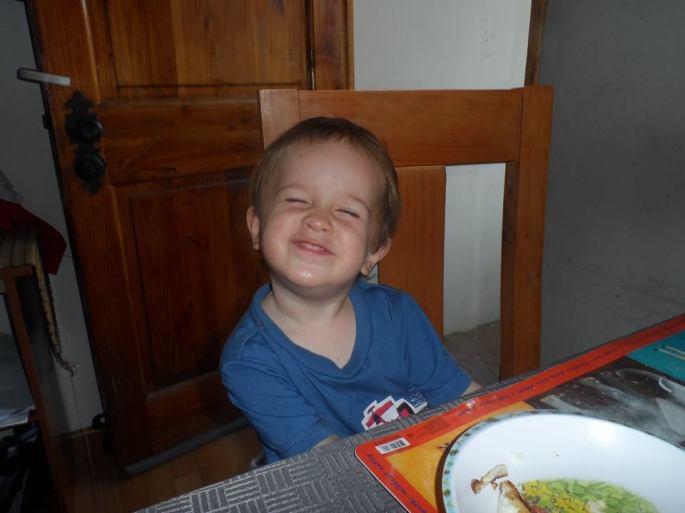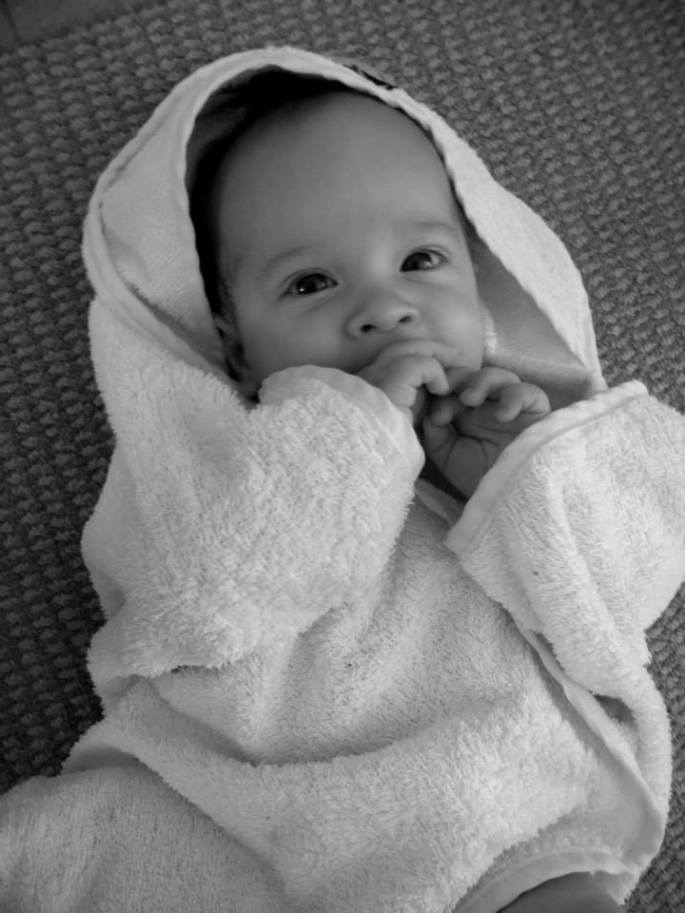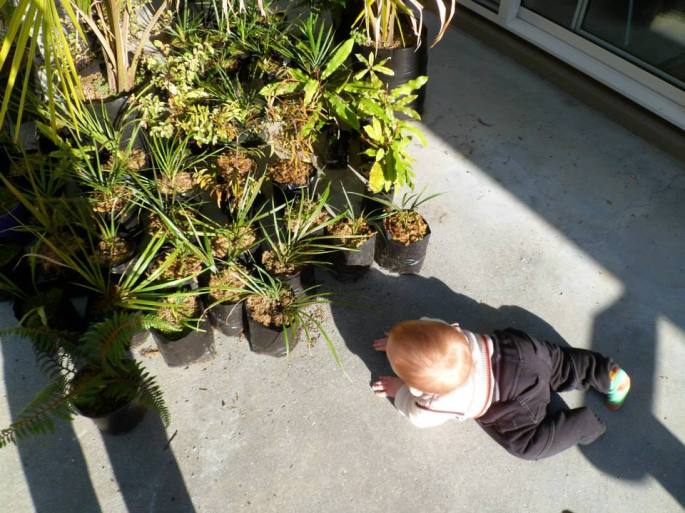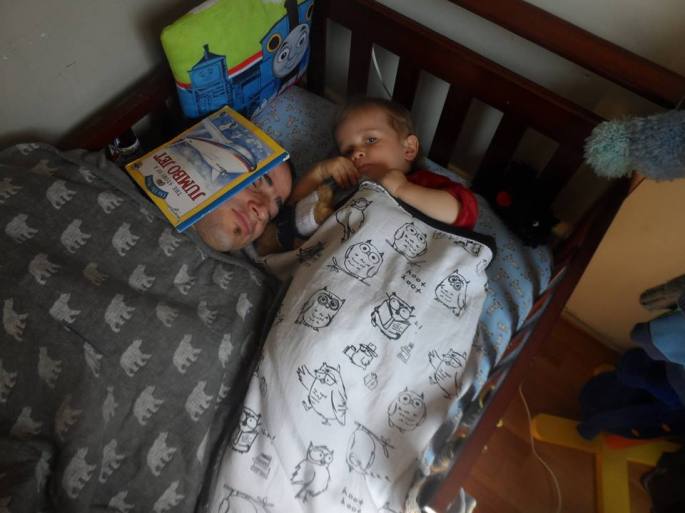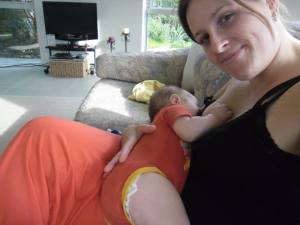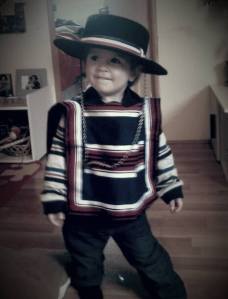It was difficult for me to decide on a ritual to observe here in Chile given that there are so many religious or secular options from which to choose. In the end I chose to closely observe my son’s first birthday party celebration. I am in the advantageous position of being in a relationship with a Chilean man, which has meant that I am lucky enough to be intimately acquainted with Chile´s foreign customs and rituals, all of which were adhered to at the birthday party. The following is my observation as a participant, focusing on numerous aspects such as colors and symbols, in addition to an analysis of their wider cultural significance. I have also included how aspects of the New Zealand culture were included and received, as well as touching on the elements of Dieciocho which were also present.
The party was held in Emiliano Zapata in the Santiago suburb of Recoleta at the beginning of Fiestas Patrias (national celebration-see below). Recoleta is a working class area that is notable for its growing immigrant population, namely from Palestine, China and Peru. It is best known for the cheap shopping district of Patronato, which includes the La Vega central market, and the national cementary. It is a gritty, dusty area with few trees or grassy areas, but does have a large population of street dogs. In wider Santiago, Recoleta is located to the north, above the colonial centre with the Plaza de Armas, while to the east are the more affluent sectors. In these areas, one passes through what is affectionately named ‘Sanhatten’ because of its skyscrapers and shopping malls. The more east of the city one travels, the wealthier the people become, and there are gated communities and mansions. There exists in Santiago a high regard for hertiage: the wealthier inhabitants pride themselves on their German or Spanish ancestry to the point where a ‘classist’ attitude has evolved. Recoleta, which was traditionally an indigenous area, is generally regarded as a poor suburb. The houses on Emiliano Zapata are a mix of bungalows and apartment blocks, with barred windows, high gates, barbed wire and guard dogs. When I first arrived in Recoleta, I noticed only the smell and the broken footpaths and potholes, but after some time here I see the efforts the locals go to, to show their originality. Many paint their houses bright colours, or paint regularly to maintain its condition. Others plant cactus or palm trees in the arid ground at the front of their doors. Each morning I look out my window and see a lady sweep the footpath near her house. Furthermore, the houses generally give very little away on the outside as to what lies inside, I have observed many a central courtyard and quite sprawling interiors. To describe the house at which the party was located, it is a two-storey building painted brown with no front door, only a black gate. There is no way to contact the inside except by calling or banging on the gate. On the ground floor is a store selling cleaning products that rents the space, and out the back there is a large yard that is also rented out as car parking spaces for people staying in the opposite flats. Upstairs is our open-plan, two bedroom home that also has a small patio. Directly ahead from here is a very large hill that is green when not obscured by smog, to the right are flats and to the left are a number of houses on the same property, shared by families living together. Our house is located several metres from an intersection that has several general stores and a newly opened Chinese takeaway.
home that also has a small patio. Directly ahead from here is a very large hill that is green when not obscured by smog, to the right are flats and to the left are a number of houses on the same property, shared by families living together. Our house is located several metres from an intersection that has several general stores and a newly opened Chinese takeaway.
The party was held because my son Emilio was turning one. As a mother, I wanted to have a party to celebrate Emilio being with us. I also wanted to enjoy the company of friends as it was only a year ago that I had to experience giving birth. It was also a great opportunity to invite alot of other babies over at the same time to meet Emilio. Therefore for me, the party was a way to bring everyone together and to socialize. My partner was a little hesitant about the demands upon him as a host (see below). However, his mother convinced him that the first birthday was an important time, for Emilio but also for the adults to take the time to enjoy him. This is understandable from either a Chilean or New Zealand cultural standpoint, but in our case especially so given that Emilio spent his first nine months with only me in New Zealand. Regardless, birthday parties are celebrated because the sociable nature of human beings means that additional meanings are placed upon the biological process of growth (Davies, 1994: 1). However, from a further anthropological standpoint, it is possible to consider my mother-in law’s eagerness for a celebration as a way to “reduce the fears that often come when life’s events threaten their security and sense of well-being”, due most likely to Emilio’s particularly international upbringing (Moro & Myers, 2010: 83). Typically in Chile , a birthday party includes a light evening meal called once that is often held around eight, however I was reluctant to prepare food given the differences in cooking between New Zealand and Chile. Here, women are trained from a young age to prepare traditional meals that are rarely deviated from, and as such, the standards are high. I did not learn to cook until I left home, and certainly not Chilean food, hence my aversion to cooking for a number of people. Therefore, four in the afternoon was chosen as it made a suitable compromise.
, a birthday party includes a light evening meal called once that is often held around eight, however I was reluctant to prepare food given the differences in cooking between New Zealand and Chile. Here, women are trained from a young age to prepare traditional meals that are rarely deviated from, and as such, the standards are high. I did not learn to cook until I left home, and certainly not Chilean food, hence my aversion to cooking for a number of people. Therefore, four in the afternoon was chosen as it made a suitable compromise.
We invited an American friend of mine and her Chilean boyfriend, the (separated) parents of my partner Luis, Luis’ older brother and his wife, Luis’ younger brother, a friend and his family, another friend and his family, a friend from university and a neighbour and their little girl. In total there were twelve adults, two children, one toddler and four babies around the age of one. Two of these babies are the offspring of two of Luis’ best friends, Andre and Felipe. Luis, Andre and Felipe were born and raised on the same street in Recoleta called Victor Cuccuini, and have been close friends since a young age. Together they have shared all the big moments in life, and along with several other people, have a group nickname, ‘Toxicuccuini’. Their three children, all around the same age, have been labeled ‘los bebes cuccuinis’ and are frequently banded together. This relationship echoes the process coined by Victor Turner known as communitas, whereby by moving through similar life phases together, these three boys “brings about a sense of community and camaraderi … [with] close bonds and will usually remain close friends throughout their lives” (Stern, 2011: 89). Today, most of the members of the Toxicocuccuini group of friends still live on Victor Cuccuini.
As a secular not religious ritual, a birthday celebration is a curious thing. While there are no rigid rules to adhere to, most certainly they contain the “fundamental beliefs, values, and social foundations of a group” (Mono & Myers, 2010: 83). The process is circular: a birthday is a rite of passage, which is an ideological ritual that dictates ones place in society, of whose place is determined by both society and rite of passage (Mono & Myers, 2010: 84). In the case of this particular birthday party, there was certainly an undercurrent of battle between the cultural forces of Chile and New Zealand, both of which were trying to make their mark. Symbolically, a birthday is an important time in one’s journey through life, however the very first birthday appears to cement the future of the child as it marks a stable condition that is recognizable by ones culture (Turner, 1967: 94). In other words, the rite of passage is a transitory period whereby one has “shed their previous identification and place in society but have yet to take on the mantle of their new status” (Stern, 2011: 89). In the case of this birthday party, Emilio lost his status as a baby the moment the party began and instead entered into one of liminality (Stern, 2011: 89). Of the features identified by Victor Turner as most often present, I can confirm that there was evidence of a transitory state, absence of property as well as the strong camaraderie of a communita and the inference of a sacred-like attitude towards Emilio (Stein, 2011: 90).
and New Zealand, both of which were trying to make their mark. Symbolically, a birthday is an important time in one’s journey through life, however the very first birthday appears to cement the future of the child as it marks a stable condition that is recognizable by ones culture (Turner, 1967: 94). In other words, the rite of passage is a transitory period whereby one has “shed their previous identification and place in society but have yet to take on the mantle of their new status” (Stern, 2011: 89). In the case of this birthday party, Emilio lost his status as a baby the moment the party began and instead entered into one of liminality (Stern, 2011: 89). Of the features identified by Victor Turner as most often present, I can confirm that there was evidence of a transitory state, absence of property as well as the strong camaraderie of a communita and the inference of a sacred-like attitude towards Emilio (Stein, 2011: 90).
To detail the order of events, the party began with the first arrival of guests around four (the American). The Chilean family members arrived at five, and I was told that “they came especially early as they know foreigners are punctual.” The friends of Luis arrived around six. Upon arrival, each person greeted with a kiss and a hug, asked how the other person was and presented a gift to myself. All the gifts were placed under the table as there was little other space to place them. Everyone took a seat around the living area and the babies were placed upon the floor, mostly watched by Felipe and Luis’ parents. The mothers mostly talked amongst themselves, and several of the men went outside onto the patio. The older children, Martin and Ignacio, played often out on the patio as well, and I remember that it was an unusually hot day. Inside, refreshments were provided over two tables. On the first table there was a very large cake modelled upon the children’s story book “Dear Zoo”. It had two levels, was yellow and had animal figures made out of the icing. On the cake was the name ‘Emilio’ and underneath on the cake board was the words, “Feliz 1st Cumple.” This cake received much attention throughout the afternoon with many of the children unable to believe that the animals were edible. Also on the table were mini cupcakes with blue icing, biscuits in the shape of Trucks with the number 1, sandwiches, a potato salad, cut up strawberries and pineapples, and muesli bars. Above the table were two birthday cards pinned to the wall, some balloons and an owl bunting with the letters of Emilio’s name. On the adjacent table were serviettes with Feliz Cumpleanos written on them, plastic spoons, plastic cups, straws and paper plates, along with bottles of Coke, water, beer and homemade Strawberry juice. I observed that the guests were reluctant to help themselves at the tables, and remained seated until all the guests had arrived. Luis then proceeded to take each plate around the room offering to each of the seated guests. He said that this was normal custom in Chile and that it is not normal to ‘help yourself.’ As a host, his job was to ensure that each guest had plenty to eat and drink, and as a result, barely sat down. Myself, as the other host, felt quite uncomfortable with this. Of the food, the cupcakes were eaten rapidly and so were strawberries dipped in chocolate.
and that it is not normal to ‘help yourself.’ As a host, his job was to ensure that each guest had plenty to eat and drink, and as a result, barely sat down. Myself, as the other host, felt quite uncomfortable with this. Of the food, the cupcakes were eaten rapidly and so were strawberries dipped in chocolate.
In terms of symbols, there were two strands at work. As we have seen above, there were balloons, cards and a bunting with the infants name. There was also music played with both English and Spanish songs. However, it is important to mention that there were decorations in the house independent of the birthday. Dieciocho is a national holiday marking Chile’s independence, and is celebrated as a week of parties known as Fiestas Patrias (patriotic parties). During this time, each house is legally obligated to fly a Chilean flag outside their home, symbolizing that they are a nation together. However, this time is typically a joyful time for Chilean families, who enjoy trips to fondas (fairs), watch military performances such as aerial shows, eat asados (barbeques food) and dance the national dance, the cueca, while wearing traditional dress. Throughout the week, houses are decorated in the colours of the flag: red, blue and white. At the party, there were garlands and wreaths in these colours across several walls. There were also traditional cueca songs played that attracted cheers and clapping. Therefore, the attitude during the celebration was considerably patriotic.
The afternoon was spent talking amongst each other, however people stayed generally in specific groupings, with the men and women separate. Conversation revolved around the children and also the house (it had been newly decorated). The outside area was very popular. Around seven, it was time for the cake. Everyone came inside, and the door was closed, lights off. The cake remained on the table as it was heavy and a candle in the shape of a number one was lit on the top. Luis stood next to me and I held Emilio, while everyone else were around us. ‘Happy Birthday’ was sung in Spanish: “cumpleanos feliz/deseamos a ti/feliz cumpleanos Emilio/que los cumplas feliz/” which is literally translated as “happy birthday/we desire for you/happy birthday Emilio/have a happy birthday”. It was sung loudly and there was much clapping and cheering at the end. The cutting of the cake marked Emilio’s entry into the liminal stage, of “transition or marginality. The individual is neither one thing or another, but ‘betwixt and between’” (Bowie, 2006: 149). After a slice of cake was eaten, we began opening the presents. This act represented the postliminal, representing Emilio’s successful pass through liminality into a new state as a one year old (Bowie, 2006: 149). What I note as striking is that in the preliminal state, Emilio played happily with everybody but during the liminal he was held closely by his parents, specifically his mother. During the opening of the presents he was again held but this time by his father. At the conclusion of the present opening, Emilio crawled away himself and spent the rest of the evening with the older children of Luis’ friends. This is notable because these actions appear as partnered to the symbolism of the rite of passage. When Emilio had completed his part in the ceremony, he was independent enough to move away as an individual who had been “reintegrated into society, but in a transformed state” (Bowie, 2006: 149). The presents themselves were particularly extravagant, consisting of a swing, toys, clothing and sports items. Everyone watched the opening of the presents with heightened anticipation, there was clapping and the whole process was filmed (rather than just photos, which were taken throughout). This rapt attention is fitting given it was the last stage of Emilio’s rite of passage.
After this stage had been completed, several people left. The immediate family stayed and partook in once. This is a custom unique to Chile and has ambiguous roots. One legend says a long time ago, eleven ladies used to clandestinely get together to drink alcohol and their code word for organising was ‘once’. Today, it does not involve eleven ladies or alcohol and instead is similar to breakfast but taken in the evening. In Chile, breakfast is typically light while lunch (at two in the afternoon) is the main meal, however as more and more families are apart during the day, once has gained more importance as important family time. Usually, freshly baked bread (preservative free) called marrequetas are served warm with ham, cheese and sometimes either stuffed tomatoes or avocado. Mashed up avocado with lemon and lots of salt almost always accompanies once, along with a spicty tomato mix called pebre. However, on the night of Emilio’s birthday we ate empanadas that were made in next doors garage. Empanadas can be fried or baked in the oven depending on what kind of filling they have, and we had either prawn and cheese, cheese or meat fillings. This was the culmination of the evening, as we all sat together and reminisced about the afternoon. Emilio was getting irritable at this point and was ready for bed, which appeared to dampen the spirits of the grandfather who could not fathom the baby being tired. At the conclusion of the meal, goodbyes were made along with the obligatory goodbye cheek kiss.
In terms of the broader socio-cultural significance, the first birthday celebration in Chile is equal to the Catholic baptism ceremony and is usually performed around the same time. The celebration has meaning for the adults as it is akin to ones affirmation within a family. In this case, Emilio’s birthday was a special one as his Chilean family were not present through his early life. It was especially significant to his grandmother, Viviana, who admitted that she was so emotional about finally having a grandchild. In South America, mothers are highly regarded and particularly close with their children. It is usual to live with ones parents until marriage, and then to live nearby and visit regularly. The birthday party provided an ideal time for bonding as the parents were busy hosting and attempting to socialize without needing to constantly attend to their child. This was especially obvious after the present opening ceremony when Emilio wandered off with a sense of new independence. Furthermore, this new stage appeared to have a dramatic effect upon Emilio, who finished the night by standing alone for the first time in his life.
Humans, when encountering danger, always respond uniquely, particularly through the use of symbols which include everything from pictograms to language. (Stein, 2011: 56). The symbols used during the party represented the slight power struggle between the New Zealand and Chilean cultures that were vying for equal footing. Spanish was only spoken, the majority of the guests were Chilean, the birthday song that marked the liminal period was sung only in Spanish despite English-speakers being present, and there were considerable displays of patriotic behaviour. In my opinion, the Chilean influence was certainly strongest, perhaps encouraged by the fact that many of the decorations were presented in Chilean colours. This then evoked a patriotic attitude because they were arbitrary symbols that provoked a similar agreement and response in the people that had been conditioned to recognise them as such (Stein, 2011: 57). The playing of Spanish music and traditional songs also set the mood of the event (Stein, 2011: 70). In terms of the broader significance of singing Happy Birthday, it is interesting and poignant that music during a rite of passage has its roots in religious ritual, of which it is a key element, as it helps to give birthday celebrations importance (Stein, 2011: 70).
It has now been several days since the conclusion of the birthday party. The sense of communitas is still strong thanks to the constant presence of the internet. Photos have been ‘shared’, ‘liked’ and commented upon along with much reminiscing. Inside the home, the decorations have come down except for the patriotic colours of red, white and blue. As we approach the day of the eighteenth itself, there is a heightened feeling of expectancy in the air. Emilio seems like a different boy, trying to walk and talk only after his rite of passage. It is evident that just as behaviours are learned so too are the meaning of symbols, all of which make an appearance during a first birthday party – from the power of the cake with its symbolic cutting, to the opening of the presents and the cheering that accompanies a national song. As a ritual, the birthday is closely tied to these elements but also to more tangible components such as a family. I observed the celebration as a bonding experience for the wider family unit (including friends formed during previous communitas) that also allowed the parents to spend time away from their child. The child himself responded to this with delight and embraced a strong sense of independence after the postliminal period had concluded.
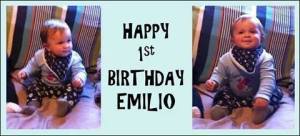
References
Bowie, Fiona. The Anthropology of Religion: An Introduction. Oxford: Blackwell, pp. 138- 173. 2006.
Davies, Douglas. Rites of Passage. Edited by Jean Holm with John Bowker. London and New York: Pinter, pp.1-9. 1994.
Mono, Pamela and James Myers. Magic, Witchcraft and Religion: A reader in the Anthropology of Religion. 2010. New York: Mc Grow-Hill, pp.83-86.
Stein, Rebecca L. and Philip L. The Anthropology of Religion, Magic and Witchcraft. New Jersey: Pearson. 2011.
Turner, Victor. The Forest of Symbols. Ithaca and London: Cornell University Press, pp. 83- 111. 1967.
